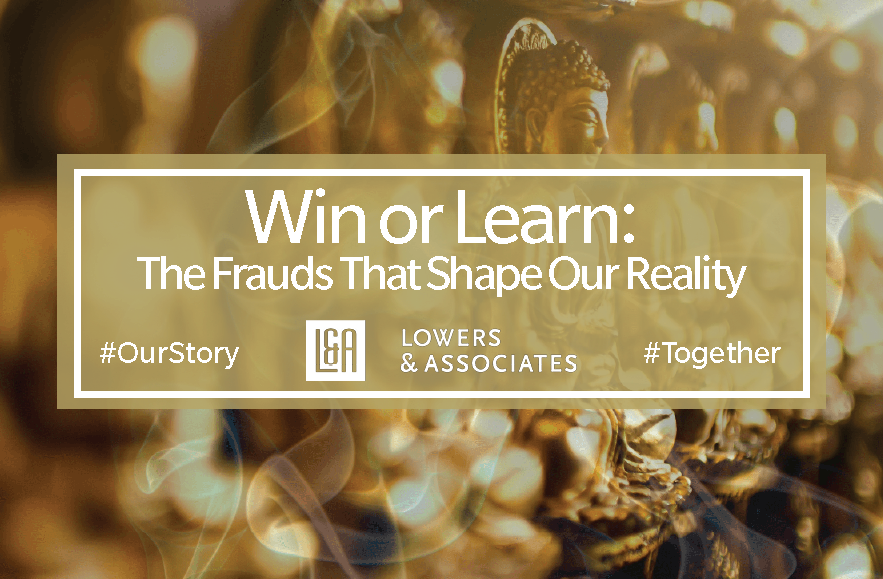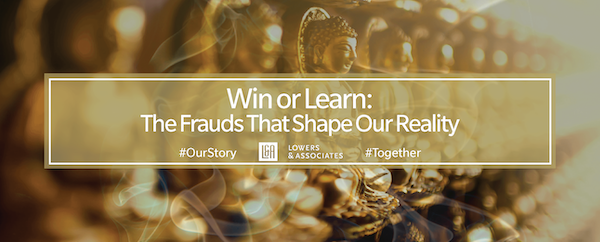
Win or Learn: The Frauds That Shape Our Reality

Disclaimer: Portions of this conversation have been edited for length and clarity, and certain locations and details have been modified for privacy reasons.
A professional fraudster demonstrates, over time, more wins than losses, presuming s/he can stay out of jail. On the flipside, a certified investigator managing fraud claims also counts more wins than losses, a fact required to remain employed. In both cases, aptitude is measured in wins over losses, but as any criminal, law enforcement officer, fighter, CEO or ballplayer will tell you, more is often learned through loss than in victory. The difference between fraud and investigator, winning and losing, aptitude and attitude is how the person in question applies loss knowledge to determine the future outcomes that shape their reality.
The fraud example above presupposes two parties on the opposite end of the spectrum, winners and losers, but what about the people in between the professional fraud and certified fraud investigator – the brokers, insurers and average Joe’s that got hoodwinked in the first place? Do their losses and learnings count? Does that loss knowledge matter? The answer is a resounding YES! to both, not only on a personal level, but on a professional level because loss can (and does) improve performance. Learners that apply loss knowledge gain perspective, sharpen their senses, develop improvisational skills, and among other outcomes, are able to better focus their desire to achieve both professional and personal goals.
Over 30 years, the Lowers & Associates team and collaborative approach has been shaped by our people’s experience trapping (and chasing) a few wild hares. It’s made us successful, and it’s in this spirit that we share the next installment of #OurStory series, courtesy of Neil Watson, Director of Global Operations for Lowers & Associates’ UK office. In his 30+ years of work, Neil has seen a few fraud cases, and in just the last 18 months, he’s identified at least six potential fraud schemes in the specie market involved precious gems and rubies. However, it was one experience early in his career as a broker evaluating a purported high-value artifact that left him “crestfallen to learn the truth” but ultimately helped inform his approach every day thereafter.
In this conversation, Neil explains how failing to recognize fraud eventually made him invaluable.
Your background is in specie. What type of frauds are most often presented to you and what do they involve?
Neil Watson: So, a lot of the frauds that come across our desks are usually for considerable values, hundreds of millions of dollars, sometimes up to $1 billion. That’s when the first red flag goes up. With a bit of research, there’s usually precedent to be able to understand what’s legitimate in the market and what needs a critical eye, regardless of the packaging and details we’re shown.
It can get a little more challenging with goods that come from the process of gold refinement, scrap and earth, as there’s lots of byproduct that comes out of a gold mine that can have a content of gold in it. We’ve seen clients who have been sold sacksful of dirt who then want to insure those bags, but they have been actively deceived. A proper eye and investigation early on can mitigate that, but you’re typically sorting out either buyer naivety or straight up fraud with those.
You’ve been at this for over 30 years now. Have you ever been duped in your career?
Neil Watson: One that still sticks in my mind was when I was a broker. It was very early in my career, predating the Internet, email, all modern technology, and I had received a package for what was purported to be the world’s largest gold Buddha. Someone wanted to insure it, I think it was out in Thailand or somewhere like that. The contact had taken the time, I remember this vividly, to put together a stellar presentation. A beautiful packet with photographs, write-ups, certificates, it had everything. Obviously, whoever did this had gone to a great deal of effort to make this statue look legitimate.
Well, as a young broker, to get this thing and have it drop in my lap, I was excited. The time and effort to put it together made me genuinely believe it was legitimate. So, I planned on trying to get some coverage for it. With a couple phone calls though, I was sensing reluctance from the conman and it became apparent to me that this was maybe not a real thing. But I was holding out hope.
One of the reasons for that, is that at the time, I was doing things for the Royal Academy like Jeff Coons’ “One Ball Total Equilibrium Tank,” for $5 million dollars. It made the idea of a giant, never-before-seen golden Buddha seem totally plausible. I had a good contact in Hong Kong, a wily old expat who’d been in the security industry for a long time and he just said, “No, mate. Absolutely not. It’s not legit.” I really trusted this guy, but I just couldn’t believe it. Lo and behold, though, after a bit more investigation and questions, poof, this thing, my contact, the whole request, disappears up in smoke. I was truly crestfallen to learn the truth of the whole thing.
At this point in your career, you’re the old guy telling all the young guys, “Ah, no.” But back then, what about this made it feel legitimate and what did you do to figure out it wasn’t?
Neil Watson: This was when I was working in London, so I didn’t have the opportunity to see the object, this golden Buddha. I can’t remember who put it on my desk, but I used to get all sorts of stuff. What impressed me most was the quality of the presentation. Anything that looks professional can pass the eyeball test. Frankly, nowadays it’s not too difficult to create a website and build out the different layers of a truly complex fraud, but back then, I was just really naively taken in, I’m quite a trusting person. I felt like, if someone’s gone and put the time and effort to put this package together then, it must be legitimate. It wasn’t stones,gems, gold dust or dirt. It was just different enough to pique the interest and it was supposed to be in the far East where they practice Buddhism. If a floating basketball could be worth $5 million, why couldn’t this thing be worth $10 million?
Nowadays, yes, I am the guy having to tell the young brokers, no. You’ve got to be patient, they’re seeing the dollar signs, thinking they’re going to get a significant premium. But with these recent rubies and gems cases, some of the questions you have ask are, “If this thing is so great, why has no one ever heard of it before? Why isn’t it in the news? Why is it not discovered? What’s it weigh, what are the dimensions? And then you slowly start to pick away at this scam, 9 times out of 10 they realize that they’ve been rumbled, the trail goes cold and you don’t hear from them again.
This experience clearly stuck with you after all these years. What were you feeling at the time?
Neil Watson: I remember being a little bit embarrassed, of course. But my contact was very kind, and the more I followed his advice and questioned this thing, the more it became a sort of realization, a learning experience. I was certainly not the first broker this happened to, and I wouldn’t be the last, so I started to ask myself, ‘What can I learn?’ The statue was different, it came nicely packaged, it was a convincing story, but within all that, it taught me I had to keep perspective, always pull off the blinders, remove myself from the tunnel vision, the immediate, and start by asking the right questions. I wanted to be ready for when the next time something like that came across, I’d have the head-start. And I was and have been since. It was truly a formative experience. Perhaps it’s made me a bit more cynical, but ultimately, it’s our job to question everything and that makes you a stronger person. Don’t believe the hype, because chances are, the hype is nowhere near its purported value.
ABOUT THE AUTHOR